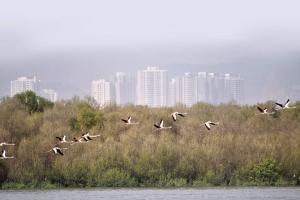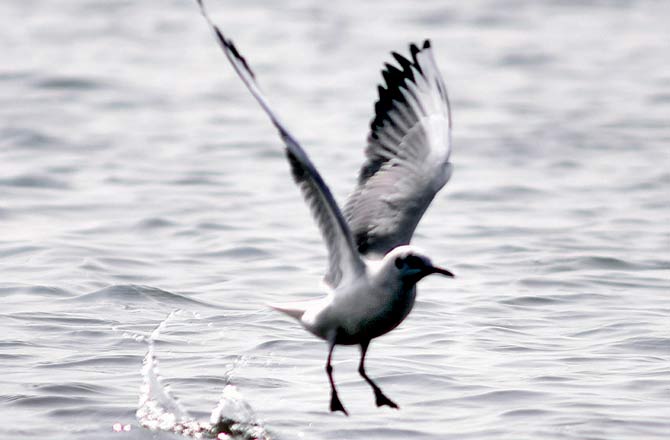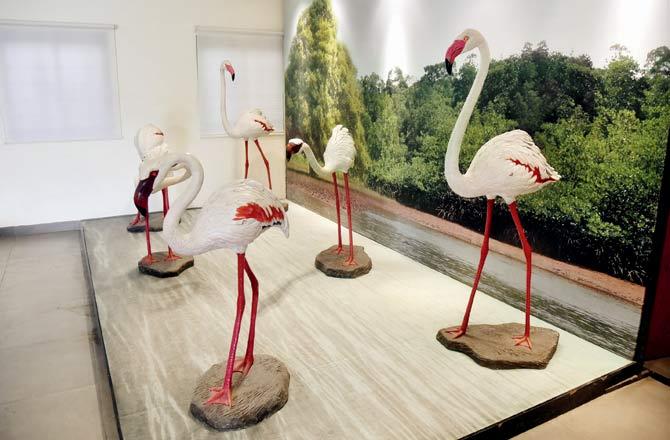A boat safari we took across Thane Creek offered a stunning insight into the flora and fauna that inhabit a critical mini ecosystem in the outskirts of Mumbai.

The anticipation is palpable among the 15 passengers aboard SB Flamingo, a small white motorboat speeding away from the backwaters of Airoli and into Thane Creek. After all, we are on our way to observe one of Mumbai's most distinctive views — the pink flamingos that migrate to the city every December and make Mumbai their home up until the next breeding season.
ADVERTISEMENT
As the boat jettisons into the open sea, the operator points to a blurry streak of pink that only a trained eye can distinguish under the shimmer of the noon sun. Along the way, we spot a flock of black-headed gulls leisurely bobbing after a hearty midday repast; they nonchalantly make way for our boat, unperturbed by our presence.

Black-headed gull
We are informed by Siddhesh Surve, assistant director (capacity building) at the Mangrove Foundation, that this is, in part, due to the boat's engine being upgraded to a more silent variant.
As the flamingos draw closer, the operator turns off the engine so we can hear the birds' distinctive call. However, it is still too early in the season for the birds to recognise our malevolence and they take off, skimming the water to build momentum before swooping into the air as a flock.

Siddhesh Surve
It is a breathtaking sight, as is noted by the clicking of cameras all around. Our operator gently manoeuvres the boat in the direction of the next flock, pointing out that these flamingos belong to the Greater Flamingo species; they can be identified by their size and black-tipped pink bill.
The other, more vividly hued but smaller species — the Lesser Flamingos — are yet to make their way to the creek from the Rann of Kutch (their breeding ground) this year. Some flocks have also been known to fly in from Pakistan, Afghanistan, Iran and Israel. Surve believes it likely that the flock in residence at the creek hails from Iran.

The boat safari offers ample views of flora and fauna. Pics/Pradeep Dhivar
Through the course of the hour-long boat ride, we spot four flocks of flamingos, two of which fly close enough for us to catch sight of the bright pink undersides of their wings. The creek is home to over 200 species of birds and on our way back, we are fortunate to spot a flock of pied avocet, another migratory species so named for its striking black and white markings (the word 'pied' stands for black and white).
As the ride comes to an end, we cannot help but ponder the consequences of unchecked urbanisation on the city's ecological landscape, the effects of which are already being felt at Sewri where construction work is keeping the flamingos away from their annual haunt.

1.2 lakh
The number of flamingos that visited the city in January. The Mangrove Foundation expects a similar number during the ongoing season
Dos and don'ts
. Carry drinking water while on the safari, especially if it's a midday safari
. Arrive early. The Mangrove Foundation has a variety of interesting exhibits that showcase the rich biodiversity of the area (in pic, above).
. Carry back all litter, especially non-biodegradable waste
. Avoid crowding on to one side of the boat. Every seat offers a ringside view of the flamingos
. Stay quiet during the safari. The birds are skittish and will take flight when disturbed
. Small children (under five years) may find the hour-long ride tiring.

To book a safari
The Mangrove Foundation operates two daily rides until April 2020. Tide timings change every week, so call the foundation (22694984/85) before making a plan. The next ride is scheduled for Friday (December 6) at 6.30 am. You pay R330 on weekdays and R440 on weekends.
Catch up on all the latest Crime, National, International and Hatke news here. Also download the new mid-day Android and iOS apps to get latest updates
 Subscribe today by clicking the link and stay updated with the latest news!" Click here!
Subscribe today by clicking the link and stay updated with the latest news!" Click here!






